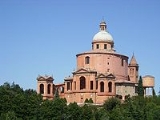
Sanctuary of the Madonna di San Luca, Bologna
Encyclopedia
The Sanctuary of the Madonna of San Luca is a basilica church in Bologna
, northern Italy
, sited atop Colle or Monte della Guardia, in a forested hill some 300 metres above the plain, just south-west of the historical centre of the city.
While a road now leads up to the sanctuary, it is also possible to reach it by traversing a long (3.5 km) monumental roofed arcade
(Portico di San Luca) consisting of 666 arches, which was built in 1674-1793. It was meant to protect the icon as it was paraded up the hill. A yearly procession proceed from the Cathedral of San Pietro in the centre of Bologna to the Sanctuary along this path. Originally the arches held icons or chapels erected by the patron family.
The Sanctuary was meant to house a miraculous icon of the virgin. A church or chapel existed atop the hill for about a thousand years. The present church was constructed in 1723 using designs of Carlo Francesco Dotti. The lateral external tribunes were built by Carlo Francesco's son Giovanni Giacomo using his father's plans. The centrally planned sanctuary has painted artworks by Domenico Pestrini, Donato Creti
(2nd chapel on right); Guido Reni
(Assumption in 3rd altar on right), Giuseppe Mazza
in chapel of St. Anthony of Padua, Vittorio Bigari
(frescoes), and Guercino (sacristy). Stucco works are by A. Borelli and G. Calegari and statues by A. Piò.
Bologna
Bologna is the capital city of Emilia-Romagna, in the Po Valley of Northern Italy. The city lies between the Po River and the Apennine Mountains, more specifically, between the Reno River and the Savena River. Bologna is a lively and cosmopolitan Italian college city, with spectacular history,...
, northern Italy
Italy
Italy , officially the Italian Republic languages]] under the European Charter for Regional or Minority Languages. In each of these, Italy's official name is as follows:;;;;;;;;), is a unitary parliamentary republic in South-Central Europe. To the north it borders France, Switzerland, Austria and...
, sited atop Colle or Monte della Guardia, in a forested hill some 300 metres above the plain, just south-west of the historical centre of the city.
While a road now leads up to the sanctuary, it is also possible to reach it by traversing a long (3.5 km) monumental roofed arcade
Arcade (architecture)
An arcade is a succession of arches, each counterthrusting the next, supported by columns or piers or a covered walk enclosed by a line of such arches on one or both sides. In warmer or wet climates, exterior arcades provide shelter for pedestrians....
(Portico di San Luca) consisting of 666 arches, which was built in 1674-1793. It was meant to protect the icon as it was paraded up the hill. A yearly procession proceed from the Cathedral of San Pietro in the centre of Bologna to the Sanctuary along this path. Originally the arches held icons or chapels erected by the patron family.
The Sanctuary was meant to house a miraculous icon of the virgin. A church or chapel existed atop the hill for about a thousand years. The present church was constructed in 1723 using designs of Carlo Francesco Dotti. The lateral external tribunes were built by Carlo Francesco's son Giovanni Giacomo using his father's plans. The centrally planned sanctuary has painted artworks by Domenico Pestrini, Donato Creti
Donato Creti
Donato Creti was an Italian painter of the Rococo period, active mostly in Bologna.Born in Cremona, he moved to Bologna, where he was a pupil of Lorenzo Pasinelli. He is described by Wittkower as the "Bolognese Marco Benefial", in that his style was less decorative and edged into a more formal...
(2nd chapel on right); Guido Reni
Guido Reni
Guido Reni was an Italian painter of high-Baroque style.-Biography:Born in Bologna into a family of musicians, Guido Reni was the son of Daniele Reni and Ginevra de’ Pozzi. As a child of nine, he was apprenticed under the Bolognese studio of Denis Calvaert. Soon after, he was joined in that...
(Assumption in 3rd altar on right), Giuseppe Mazza
Giuseppe Mazza
Giuseppe Mazza was an Italian sculptor of the Rococo period. He was active in Bologna, as well as Ferrara, Modena, Pesaro, and Venice. His masterpiece is a series of monumental reliefs for the Capella di San Domenico in the Basilica of Santi Giovanni e Paolo in Venice Giuseppe Mazza (1653–1741)...
in chapel of St. Anthony of Padua, Vittorio Bigari
Vittorio Bigari
Vittorio Bigari was an Italian painter of the late-Baroque. He was active in his native Bologna, where he was a pupil of Antonio Dardani. He painted frescoes in the Basilica of San Domenico in Bologna, as well as the cupola of the church of the Madonna della Guardia, and the gallery of the...
(frescoes), and Guercino (sacristy). Stucco works are by A. Borelli and G. Calegari and statues by A. Piò.

